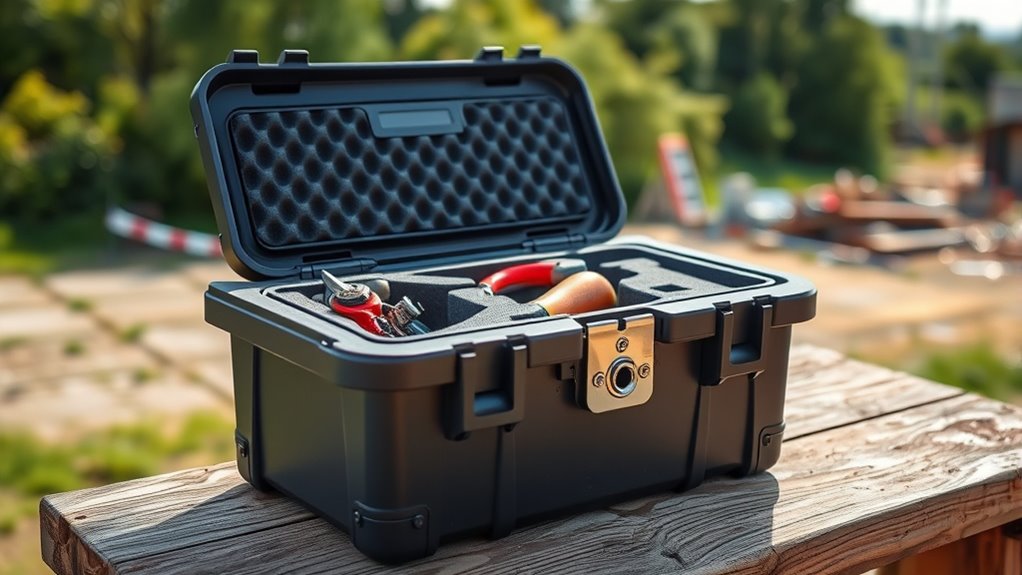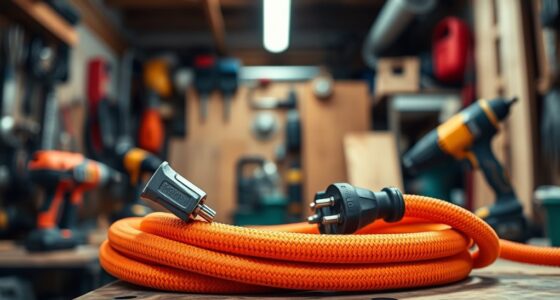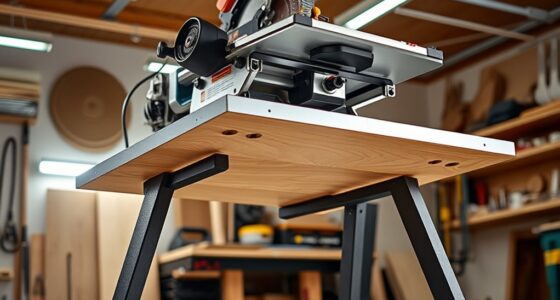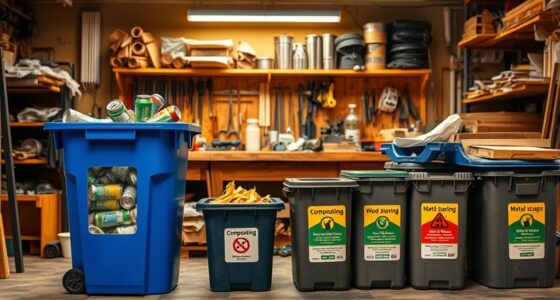When choosing a portable toolbox for field work, prioritize durability, lightweight design, and ease of handling. Look for those made from tough materials like reinforced steel or durable plastics that resist damage and corrosion. Consider weight to ensure easy transport over various terrains and check for secure closures and organized compartments. A well-balanced toolbox minimizes fatigue and enhances safety. To make the best choice, you’ll find helpful tips on balancing durability with portability and practical features as you explore further.
Key Takeaways
- Prioritize lightweight, durable materials like plastic or aluminum for easy transport and long-term use.
- Ensure the toolbox has secure closures and organized compartments for quick access and tool safety.
- Consider ergonomic handles or wheels to improve handling and reduce physical strain during movement.
- Assess the toolbox’s resistance to environmental factors such as moisture, corrosion, and impacts.
- Balance storage capacity with portability to match the specific needs of your field work environment.

When choosing a portable toolbox for field work, you need a solution that balances durability, organization, and ease of transport. The material durability of your toolbox is crucial because it determines how well it withstands harsh environments, impacts, and exposure to the elements. You want a toolbox made from robust materials like high-impact plastic, reinforced steel, or aluminum, which resist dents, cracks, and corrosion. This guarantees your tools stay protected during transport and rough handling. Keep in mind that the durability of the material also affects long-term usability; investing in a sturdy box often means fewer repairs or replacements over time, saving you money and hassle in the long run. Additionally, understanding the weight of your toolbox helps in planning for ease of movement and transportation. Weight considerations play a significant role in selecting the right toolbox. A lightweight design is essential because you’ll be moving it around frequently, sometimes over uneven terrain or long distances. Heavy-duty materials like steel provide excellent protection but can add significant weight, making transport more cumbersome. Conversely, lighter options such as durable plastics or aluminum strike a good balance, offering sufficient strength without becoming a burden. Think about how much you’ll need to carry at once and the distances involved. If you’re often climbing ladders or maneuvering through tight spaces, a lighter toolbox can make your job less strenuous and reduce fatigue.
Choose a durable, impact-resistant toolbox made from high-impact plastic, reinforced steel, or aluminum for reliable field protection.
Additionally, consider how the material impacts ease of handling and safety. A heavy, poorly balanced toolbox can cause strain or injury, especially when you’re lifting or maneuvering it in tight spots. On the other hand, a well-designed, lightweight box with sturdy handles or wheels can enhance mobility and safety. Some toolboxes feature ergonomic grips or telescoping handles, which are particularly helpful if you frequently transport your tools over longer distances or rough terrain.
While focusing on material durability and weight considerations, don’t forget to check how these factors influence the overall design. A durable, lightweight toolbox should still offer ample storage compartments, secure closures, and easy access to your tools. The goal is to find a balance: a box that’s tough enough to protect your tools, light enough to carry comfortably, and practical enough to keep your tools organized and within reach.
Frequently Asked Questions
How Durable Are Plastic Versus Metal Toolboxes?
Plastic toolboxes are generally less durable than metal ones, but they excel in weather resistance, resisting rust and corrosion better. Metal toolboxes, especially steel or aluminum, offer greater strength and longevity, making them suitable for heavy-duty use. However, they can be prone to rust if not properly coated. Your choice depends on your work environment: if weather resistance is a priority, plastic may be better; for durability, go metal.
Can I Customize Compartments in a Portable Toolbox?
Yes, you can customize compartments in a portable toolbox. Think of it as crafting a personalized map, where modular compartments and adjustable dividers serve as your guiding landmarks. They let you configure the space to fit your tools perfectly, turning chaos into order. With these features, you’re in control, ensuring every tool has its place, making your field work more efficient and less stressful.
What Is the Best Weight Limit for Carrying?
You should aim for a weight capacity that feels manageable for you, typically around 20-30 pounds, depending on your strength and the tools you’ll carry. An ergonomic design helps distribute weight evenly, reducing fatigue and strain. Look for a toolbox with a sturdy handle and balanced construction, so you can carry it comfortably over long distances. Prioritize comfort and safety to avoid injury during your field work.
Are Waterproof Toolboxes Suitable for All Weather Conditions?
Waterproof toolboxes are highly suitable for all weather conditions because they offer excellent weather resistance and corrosion protection. You can rely on them to keep your tools safe from rain, snow, and humidity, preventing rust and damage. Their sturdy sealing and durable materials ensure your tools stay dry and protected, making them ideal for demanding outdoor environments. With a waterproof toolbox, you won’t worry about weather ruining your equipment.
How Secure Are Locking Mechanisms on Portable Toolboxes?
Locking mechanisms on portable toolboxes provide pretty good protection, but their security features vary. You can trust sturdy locks to keep your tools safe from sneaky thieves, yet some cheaper models might lack reliable security. It’s wise to choose a toolbox with robust locking mechanisms that resist tampering. Always double-check the lock’s durability and security features, so you stay secure and your tools stay protected during your field work adventures.
Conclusion
Choosing the right portable toolbox makes your field work more efficient and stress-free. With so many options available, you might wonder if you’re missing out on features that could save you time and effort. By considering your specific needs, weight, durability, and organization, you’ll find a toolbox that truly works for you. Isn’t investing a little time in selecting the right one worth it for smoother, more productive days in the field?









